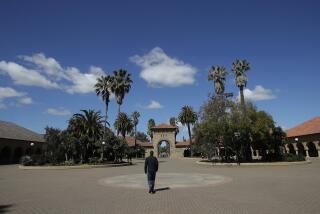Lessons From Affirmative Action’s Past
Seattle lawyer Marco DeFunis died at age 52 in January 2002. Only his hometown newspaper published an obituary, but its front-page placement demonstrated how, once upon a time, DeFunis had been something other than a personal injury lawyer.
Yet amid the scores of recent news reports heralding Tuesday’s Supreme Court oral arguments in two landmark lawsuits challenging affirmative action admissions programs at the University of Michigan, DeFunis’ name is strangely missing. That absence is unfortunate. Allan Bakke became a household name as a result of the 1978 Supreme Court decision that admitted him to the UC Davis medical school and voided a racial admissions quota. But in 1971, DeFunis’ complaint about his rejection from the University of Washington’s law school had for the first time confronted the high court with the constitutional issue that again is squarely before the nine justices and that has become one of the roiling ideological issues of our time.
Ironically, DeFunis’ lawsuit began not as a challenge to special preferences but as a demand for one. Enlisting his parents and his spouse as co-plaintiffs, DeFunis complained that the law school had rejected him, notwithstanding his family’s status as Washington state “residents and taxpayers ... for more than 50 years,” while nonetheless accepting scores of out-of-state applicants whose families had never supported Washington’s public institutions. “Taxpayers and residents of the state,” DeFunis’ suit asserted, “are entitled to preference for admission to the state university.”
But the law school’s response to DeFunis’ lawsuit revealed something unexpected: The university had different admission standards for African Americans, Latinos, Native Americans and Filipinos. Only when records showed that more than three dozen such candidates whose grade-point averages and standardized test scores were lower than DeFunis’ were accepted was his case transformed into a challenge to racially preferential admissions.
Judge Lloyd Shorett, faced with those glaring statistical disparities, almost immediately ordered DeFunis’ admission to the law school. Eighteen months later, the Washington Supreme Court reversed Shorett, and DeFunis appealed to the U.S. Supreme Court. In June 1973, Justice William O. Douglas blocked the state court ruling, and DeFunis began his final year of law school just weeks before the U.S. Supreme Court agreed to hear his appeal.
The briefs and arguments that now confront the high court in the Michigan cases are starkly reminiscent of those that it considered in the DeFunis case. In DeFunis, one of the most striking submissions came from Yale law professor Alexander Bickel, who was widely revered as a premier constitutional commentator. Asserting, on behalf of the Anti-Defamation League of B’nai B’rith, that any governmental use of racial classifications must be strictly limited, Bickel warned the justices that without clear limits, “the remedy of affirmative action will collapse into the very evil it seeks to cure; and then surely the impulse to abandon it altogether will be irresistible.”
Bickel’s warning that affirmative action “will end up destroying itself” may seem prescient to observers who believe that today’s Supreme Court agreed to hear the Michigan cases for the express purpose of striking down preferential admissions. But when the justices of three decades ago eventually decided that DeFunis’ impending graduation from law school could allow them to avoid a full-dress analysis of the constitutionality of racially preferential admissions, Justice Douglas, a liberal veteran, nonetheless addressed the substantive merits. Noting that the law school acknowledged applying different standards depending on an applicant’s race, Douglas asserted that admissions decisions must be made “on the basis of individual attributes, rather than according a preference solely on the basis of race.” DeFunis, Douglas said, “had a constitutional right to have his application considered on its individual merits in a racially neutral manner.”
But Douglas’ invocation of “racially neutral” did not mean he was championing some simple “colorblind” model. Instead, Douglas explained that distinct treatment based on race or some other debatable attribute could pass constitutional muster if “the reason for the separate treatment of minorities as a class is to make more certain that racial factors do not militate against an applicant or on his behalf.” Douglas had in mind the question of whether higher education’s reliance on standardized test scores inherently disadvantages some groups of applicants, and how that could be counterbalanced.
Yet the subtle precision of Douglas’ formulation points the way toward where today’s Supreme Court should head: Require higher education to adopt selection practices that truly examine each applicant’s individual merits, including racial and ethnic identity, but not accord such identities any systematic advantage.
The Michigan undergraduate program’s fatal flaw was that it automatically awarded “bonus points” based solely on race. If university admissions offices were barred from simplistic reliance on both standardized tests and racial pigeonholing, individual excellence and institutional diversity might both be enhanced.
More to Read
Sign up for Essential California
The most important California stories and recommendations in your inbox every morning.
You may occasionally receive promotional content from the Los Angeles Times.










